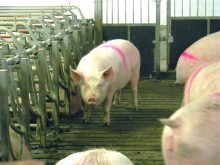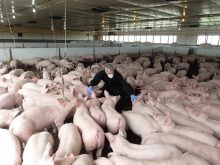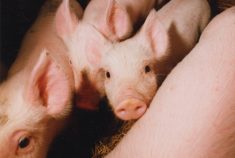A rash of hog barn construction is about to break out in Manitoba.
Two formal applications for new hog barns have gone through in the last two weeks and the Manitoba Pork Council is getting a growing number of phone inquiries from producers.
Mike Teillet, MPC’s sustainable development manager, said some inquiries are just tire kicking. But genuine interest has picked up in the last two months and producers are now increasingly serious about starting construction.
“This is for real,” Teillet said during a break in the Manitoba Pork Council’s annual meeting in Winnipeg last week.
Read Also

Mazergroup’s Bob Mazer dies
Mazergroup’s Bob Mazer, who helped grow his family’s company into a string of farm equipment dealerships and the main dealer for New Holland machinery in Saskatchewan and Manitoba, died July 6 from cancer.
The two official applications so far are from the south Interlake and north of Brandon. Both are for brand new operations, said Teillet.
Teillet said he received four phone inquiries in the two days prior to last week’s annual meeting and expected more once he got back to his office.
There’s a lot of pent-up demand for new hog barns in Manitoba, following a moratorium, either total or partial, stretching back nearly 10 years, he said.
The province first implemented a temporary freeze on new hog barn construction in Manitoba in late 2006, pending a Clean Environment Commission review of the province’s hog industry. In 2008, the government passed Bill 17 which banned new construction in 35 municipalities in southern and eastern Manitoba, as well as in the Interlake. Finally, in 2011, the province adopted The Save Lake Winnipeg Act which effectively prevented new or expanded hog barns throughout the province.
However, in April 2015, the province and producers agreed on a pilot project allowing new barns if they meet certain environmental requirements such as two cell lagoons and limits on soil phosphorus.
The result is the current spike in interest which could lead to a resurgence of hog production in Manitoba.
Teillet said the timing is critical because Manitoba pork packers face a shortage of pigs at a time when many aging hog barns in the province need replacing.
Other favourable factors for hog expansion include: lower grain prices which encourage livestock feeding, a low Canadian dollar which promotes exports, and more flexible lending policies from key financial institutions.
An important development occurred recently when Farm Credit Canada agreed to lend producers 65 per cent of the price of a new barn based on their cost of construction, not current market value.
Because many Manitoba hog barns are 25 to 30 years old, their market value is low and loans based on that would be too small. Basing loans on construction costs instead enables producers to finance a bigger portion of their building expenses.
“With this, everything turns around,” Teillet said.
He added producers today are better equipped to afford loans after paying down debt during a period of record prices in 2014.
Manitoba Pork has asked DGH Engineering to prepare detailed budget estimates for building 2,000- and 4,000-head finisher barns. The plans aim at giving producers an idea of the potential costs of constructing new facilities.
The council has also published a 50-page guide on the approval and regulatory processes for starting or expanding pig farms in Manitoba.
All these developments are signs the long-suffering hog industry has finally turned a corner, said Teillet.
“I’ve been here for 8-1/2 years and I’ve never felt the kind of energy and excitement I do now.”
The prospect of new hog barns and increased production is welcome news to Manitoba processors who have been operating below slaughter capacity for several years.
Andrew Dickson, Manitoba Pork general manager, told delegates processors need 1.3 million more finished pigs a year to fill their capacity. Meeting that demand would require the equivalent of 80 new barns each with 4,000 pigs at a total construction cost of $160 million.
The demand for more pig production in Manitoba is even bigger when exports are considered.
Producer delegations from Iowa and Minnesota told the meeting that five new hog plants in four Midwestern states are expected to come on stream within the next two years. Several have the capacity to slaughter 10,000 pigs a day and could require imports from outside their borders to help fill them.
Livestock exports to the U.S. have been stimulated lately by the low Canadian dollar and the recent repeal of the U.S. country-of-origin labelling rule which restricted foreign live swine and cattle shipments.
George Matheson, MPC chairman, said signs for the industry in the year ahead are positive. Prices, although down from the 2014 peak, were still decent in 2015 and are expected to remain level in 2016. Manitoba’s pig producers largely escaped last year’s PED virus outbreak which severely affected U.S. operations. Also, several recent international trade deals are expected to boost Canada’s pork exports.



















